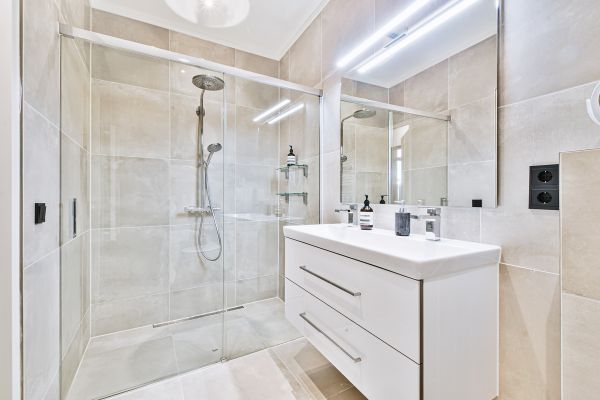If you’ve ever walked into your bathroom and noticed that musty smell or spotted little black specks creeping along the ceiling, you already know what poor ventilation can do. Mold, mildew, peeling paint — not exactly the vibe anyone wants in their home. The good news? A few smart bathroom ventilation tips can help you keep things fresh, dry, and clean without much hassle. Let’s get into it.
Why Bathroom Ventilation Matters More Than You Think
Bathrooms are basically humidity factories. Every shower, bath, or even a quick face wash adds moisture to the air. Without proper ventilation, that moisture lingers — seeping into walls, ceilings, and grout. Over time, it causes mold growth, paint damage, and even structural issues.
The thing is, most people don’t realize how fast this can happen. One steamy shower can raise humidity levels to 90% in minutes. If that moisture doesn’t escape, your bathroom becomes a perfect breeding ground for mold spores.
So, if you’re wondering whether it’s worth paying attention to ventilation, trust me — it absolutely is.
Start with a Good Exhaust Fan
When people talk about bathroom ventilation tips, exhaust fans are always the first thing that comes up — and for good reason. A properly sized, well-installed fan is your bathroom’s best defense against moisture buildup.
If your fan is weak or noisy, it’s time for an upgrade. Look for one with the right CFM (cubic feet per minute) rating for your bathroom size. A small powder room might do fine with 50 CFM, but a large master bath with a tub and shower could need 100 CFM or more.
Pro tip: Don’t just run the fan while showering. Leave it on for at least 15–20 minutes afterward. That’s the time it takes to clear out lingering humidity.
Clean the Fan Regularly
Even the best fan won’t help much if it’s clogged with dust. Every few months, take off the cover and gently vacuum or wipe it down. You’ll be surprised how much gunk builds up there. This small act keeps the fan running efficiently — and quietly too.
It’s one of those simple bathroom ventilation tips that most people forget about until the fan starts making that annoying rattling noise.
Let Natural Air Do Its Job
If you’re lucky enough to have a window in your bathroom, use it. Open it up during or after a shower to let fresh air in and steam out. It’s a free, natural way to balance humidity levels.
You can even combine natural and mechanical ventilation — run your fan and open the window at the same time. This helps moisture escape faster and keeps your bathroom smelling fresher.
And hey, on sunny days, natural sunlight helps too. UV rays can actually kill some mold spores, so letting a bit of light in is another subtle but effective trick.
Keep the Door Open After Showers
Here’s one of those bathroom ventilation tips that seems too simple to matter — but it does. Leave the bathroom door open after you shower. Let that steam wander off into the rest of your home instead of trapping it inside four walls.
If you have an air vent or central HVAC system nearby, it’ll help redistribute that moisture so it doesn’t stay concentrated in one place.
Use a Dehumidifier if Needed
In some homes — especially in older buildings or small apartments — there’s just not enough airflow no matter what you do. That’s where a small portable dehumidifier can work wonders.
Place it on the counter or floor after a shower to suck up excess moisture. It’s not a replacement for proper ventilation, but it’s a solid backup plan.
You’ll know it’s working when you check the water collection tank and see how much humidity it’s pulling out of the air.
Fix Leaks and Seal Cracks
Proper ventilation isn’t just about moving air — it’s also about controlling moisture at the source. If you have a leaky faucet, dripping showerhead, or poor caulking around your tub, that’s constant moisture feeding mold.
Regularly check for soft spots on walls, bubbling paint, or discolored grout. Those are early signs that water’s sneaking in somewhere it shouldn’t. The sooner you fix those issues, the easier it is to keep your bathroom dry and clean.
Choose the Right Paint and Materials
If you’re remodeling or repainting, go for materials that can handle humidity. Semi-gloss or satin paints are ideal since they resist moisture better than flat finishes. Likewise, use mildew-resistant caulk and grout — small details that make a big difference.
These aren’t just aesthetic choices; they’re part of smart bathroom ventilation tips that help your space stay healthy long-term.
Keep Towels and Rugs Dry
This one’s often overlooked. Damp towels and bathmats hold onto moisture, raising humidity in your bathroom. Hang them up properly or toss them in the dryer after use. Even better, install a heated towel rack if you can — they’re stylish and practical.
You’ll notice your bathroom smells fresher and feels less clammy just by keeping textiles dry.
Regularly Check for Mold — and Act Fast
Even with great ventilation, some moisture is inevitable. Keep an eye out for mold spots on the ceiling, tile grout, or behind the toilet. If you catch them early, they’re easy to clean with vinegar or a mild bleach solution.
But if you ignore them, mold spreads fast — and cleaning becomes a nightmare. So, add “quick mold check” to your regular cleaning routine. Prevention beats deep scrubbing any day.
Create an Airflow Habit
Good ventilation isn’t a one-time thing — it’s a habit. Get used to turning on the fan, cracking open the window, wiping down wet surfaces, and checking for leaks. These small steps add up. Over time, they’ll make your bathroom feel fresher, cleaner, and less like a steam room.
Final Thoughts on Bathroom Ventilation Tips
Let’s be real — nobody enjoys scrubbing mold off the ceiling or dealing with peeling paint. But the truth is, it’s easy to prevent if you take ventilation seriously. These bathroom ventilation tips aren’t fancy or complicated. They’re just small, everyday habits that keep your space healthy and comfortable.
So next time you hop out of the shower, remember to flip that fan switch, open the window, or leave the door ajar. A few minutes of airflow now can save you hours of cleaning later — and that’s a trade anyone can get behind.
Because at the end of the day, a dry bathroom is a happy bathroom — and yours deserves to stay that way.







